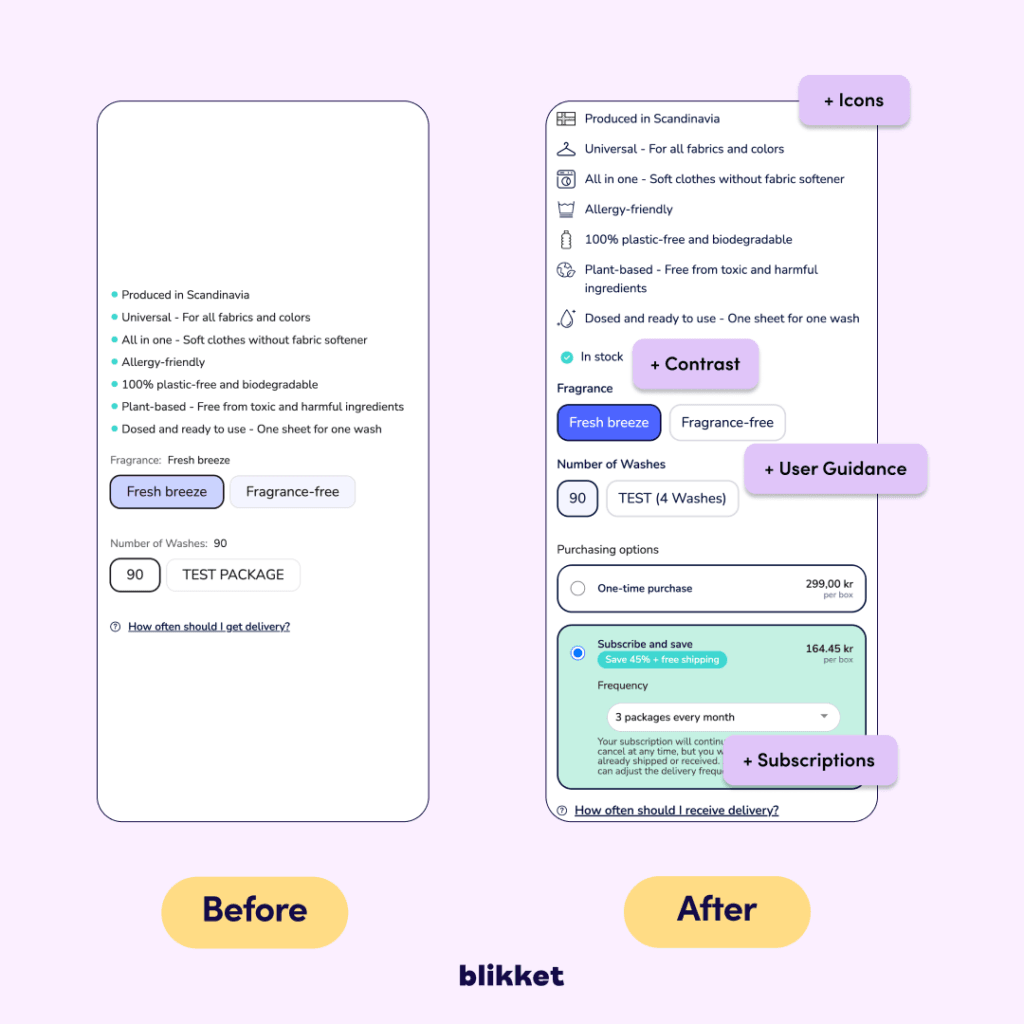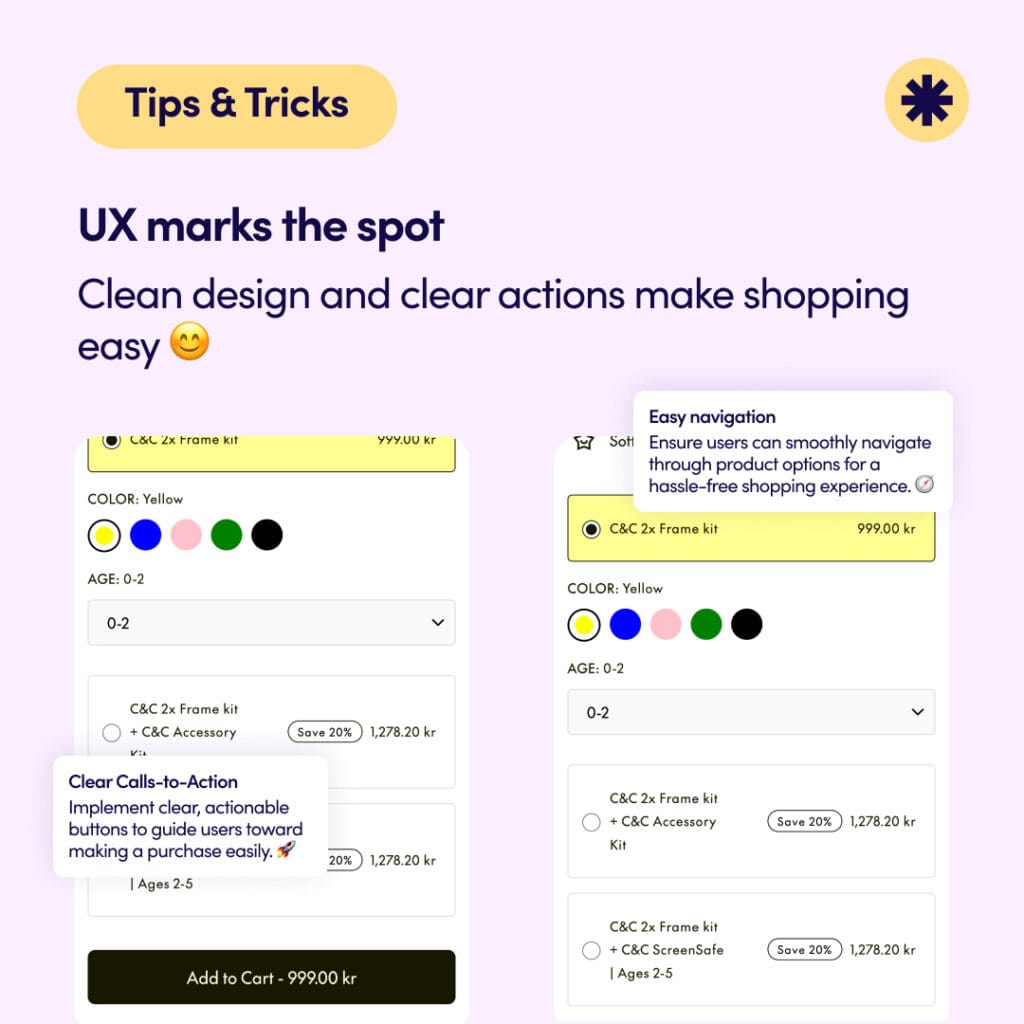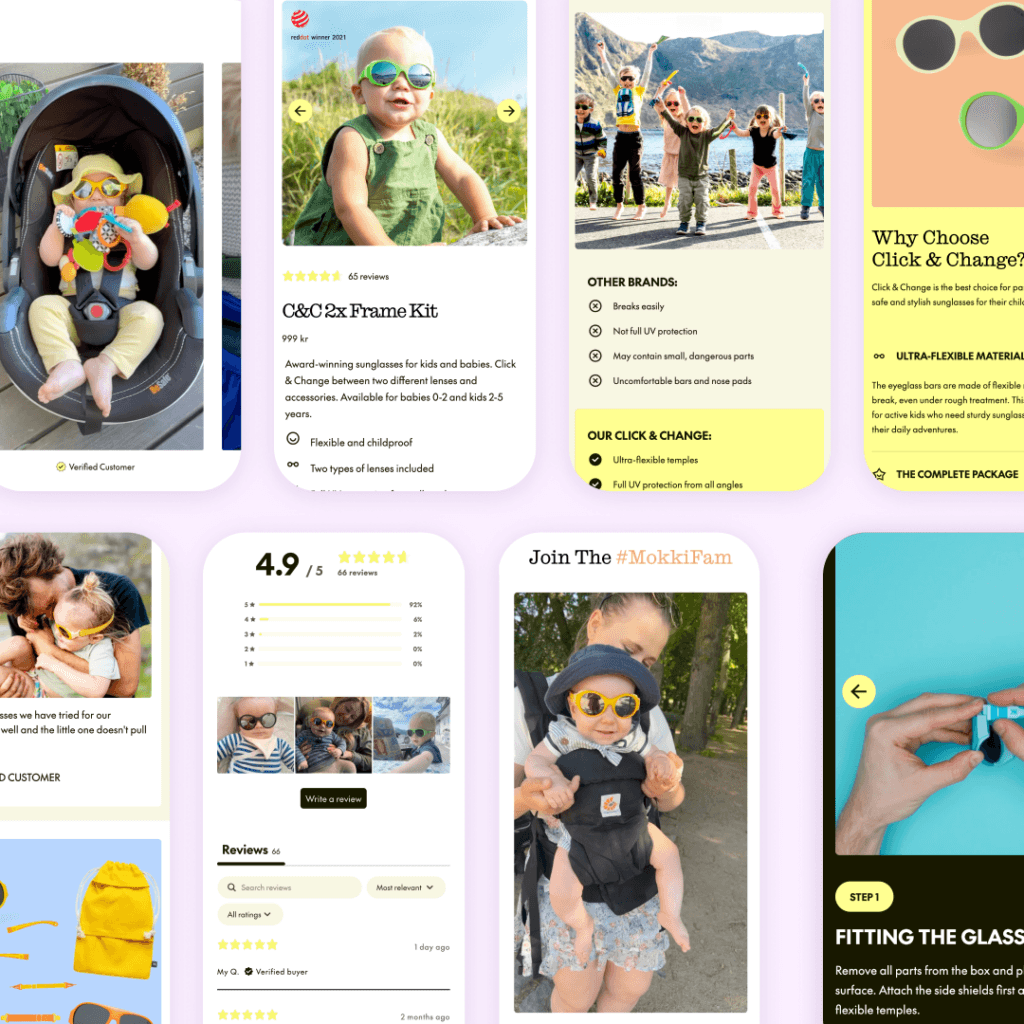Mastering UX Design: Your eCommerce Sales Booster
As the month draws to a close, the digital marketplace buzzes with new trends, strategies, and updates that every eCommerce marketer, owner, and manager should stay top of. In the whirlwind of the rapidly evolving eCommerce realm, one element consistently prevails in importance: User Experience design.
This week at “The Checkout Point by blikket.co,” our hosts Max and Rachel unpack the potent weapon in your eCommerce arsenal—exceptional UX design combined with Conversion Rate Optimization strategies. Amidst updates from giants like Amazon, eBay, and Shopify, and the unfolding drama at Etsy, the focus remains sharply on how enhanced UX can massively propel your sales forward.
With a freshly minted blog post stirring the community, “eCommerce Secrets: Boost Your Sales with UX Design and CRO Strategies,” there’s more than enough reason to dive into the complexities of UX. This crucial facet of eCommerce is more than just aesthetics; it’s about creating seamless, enjoyable shopping experiences that not only retain customers but also turn them into enthusiastic promoters of your brand.
As April peeks around the corner, and tech innovations continue to sprout, the importance of staying updated with the latest UX strategies has never been more critical. From the security enhancements to understanding the implications of major shifts at industry titans, mastering UX design is not just an option—it’s a necessity in safeguarding and amplifying your eCommerce success.
Ready to transform your user experience and see your conversion rates soar? Stick around as we delve deeper into actionable tips and insights right here on “The Checkout Point.”
Unlocking the Power of UX Design in eCommerce
As the digital marketplace grows increasingly competitive, eCommerce sites must continually evolve to meet the ever-changing demands of consumers. A pivotal aspect of this evolution centers on the enhancement of the shopping experience through User Experience (UX) design and Conversion Rate Optimization strategies. To this end, understanding and implementing effective UX design is not merely an aesthetic consideration—it’s a crucial business strategy to improve functional performance and overall customer satisfaction.
Enhancing Functionality Beyond Aesthetics
The common misconception that UX is about making a site look visually attractive is far from its primary purpose. In practice, UX is fundamentally about creating an efficient, accessible, and pleasurable experience for the user. This involves designing intuitive navigation paths, simplifying search functionalities, and ensuring that page loading times are minimized. Addressing these aspects can markedly decrease your site’s bounce rates and amplify conversion rates.

Streamlining the Checkout Process
Imagine being a customer who has navigated through an online store, filled their cart, only to abandon it at the last minute due to a confusing or time-consuming checkout process. Sounds frustrating, right? This scenario is far too common, and as highlighted in the Blikket blog post, optimizing the checkout process is critical in reducing cart abandonment and boosting sales. Ensuring that your checkout is as straightforward as possible is not just about reducing steps, but about creating a seamless flow that leads the customer confidently towards making a purchase.
Leveraging CRO through A/B Testing
When it comes to refining the user experience, data is king. This is where A/B testing becomes invaluable. By testing different elements of your website, from button colors and call-to-action placement to headline wording and image selection, you can gather data on what changes positively affect user behavior and conversion rates. With each test, you gain insights that assist in making informed decisions that could dramatically influence the effectiveness of your UX strategy.
Understanding the Customer’s Journey
Developing empathy for your customers by understanding their journey from the moment they land on your site until they complete a purchase can reveal numerous opportunities for enhancement. It’s about stepping into their shoes and perceiving your online store from their perspective. This empathetic approach can unearth subtle yet critical elements that might otherwise be overlooked but could have a substantial impact on user experience and sales conversions.
With the start of a new month just around the corner, now is the ideal time to consider what strides can be made in your UX and CRO efforts. Whether you’re looking to overhaul your entire site or just tweak a few elements, every change should aim to enhance how users interact with your site and lead to better sales conversion rates.
Remember: It’s not just about employing new technologies or trends—it’s about creating a consistently effective and enjoyable shopping experience that keeps your customers coming back. For more in-depth discussions on this topic and practical examples, do check out the full post, eCommerce Secrets: Boost Your Sales with UX Design and CRO Strategies.

Revolutionizing Online Card Trading with eBay’s New Grading Feature
In a bold move that could significantly enhance the online trading card market, eBay is now rolling out a grading service during the card authentication process. This addition promises to transform how collectors purchase cards online, offering a clearer insight into the quality and value of their buys. Let’s dive deeper into how this might change the game for collectors and sellers alike.
Typically, the condition of a trading card plays a crucial role in its value—factors like the corners, color, and overall integrity of the card are scrutinized closely. Up until now, assessing the condition of a card bought online could be somewhat of a gamble. However, with eBay’s new grading service, collectors can receive a professional assessment of a card’s condition before making a purchase, akin to having a report card for each potential buy.
Boosting Buyer Confidence and Streamlining Transactions
By integrating grading into the authentication process, eBay is not only enhancing transparency but also boosting buyer confidence. Collectors can now make more informed decisions, knowing the exact grade of the card as determined by professionals. This service effectively removes a layer of uncertainty from online trading and could potentially increase the volume of transactions, as buyers may feel more secure in their purchases.
This strategic update by eBay could be seen as a direct response to the growing demand for more reliable and user-friendly eCommerce experiences. Enhancing user experience (UX) aligns perfectly with contemporary eCommerce trends that prioritize customer satisfaction and trust.
In parallel, Amazon is also making strides in enhancing user experiences by establishing pickup and return locations at military installations, streamlining the process for service members and their families. This thoughtful integration of services highlights how major online platforms are continuously evolving to meet user needs in innovative ways.
Both initiatives reflect a broader shift towards more personalized and user-centered eCommerce platforms. As these developments unfold, it will be fascinating to see how they influence user engagement and satisfaction, potentially setting new standards for the online retail experience.
For eCommerce platforms, the message is clear: the future lies in innovative solutions that enhance user experience and build greater trust in digital transactions. With companies like eBay and Amazon leading the way, the landscape of online shopping is set to evolve dramatically, offering users not just products, but complete, satisfactory shopping experiences.
Navigating the Bumpy Road of UX Design in eCommerce Platforms
In the fascinating world of eCommerce, particularly on platforms like Etsy, the journey from a quirky online shop to a flourishing business can face unexpected turbulence, notably in facets like user experience (UX) and account verification processes. Recently, Etsy made headlines not just for innovative steps but for operational hiccups that are causing a stir among its sellers.
Imagine the scene: you’ve meticulously crafted your online shop, filled it with unique items like handmade wizard hats or cookies shaped like famous memes. Just as you begin to bask in the glow of your creativity and entrepreneurial spirit, you’re jolted by a request for account verification from Etsy. Sounds simple, right? Think again. Recent reports suggest that this process has morphed into a confusing ordeal for many.
The UX Challenge of Account Verification
The concept of account verification, while fundamental for security—thwarting scam artists and bots—has unfortunately turned into a cumbersome blockade for several legitimate sellers. This process, ideally a minor checkpoint, can feel as daunting as recalling whether your backup email was “coolcat123” or “supercoolcat1234.” For eCommerce platforms, where the fluidity of transactions and user convenience are paramount, such friction can detract significantly from the user experience.
This snag is not just a minor inconvenience. For sellers who rely on their Etsy income, being locked out during the verification process is akin to a surprise pop quiz in math—unexpected and panic-inducing. The disruption can halt sales and alienate customers, ultimately impacting seller revenues and platform reliability.

Hope on The Horizon with New Leadership
In a promising development, Etsy has recently onboarded a new Chief Technology Officer from Depop, as outlined in this announcement. The eCommerce community is buzzing with optimism that this strategic move might herald enhancements, especially in streamlining cumbersome processes like account verification. The introduction of fresh, tech-savvy insights could be precisely what’s needed to refine these aspects, enhancing the overall UX for sellers and buyers alike.
As we edge closer to April, not only are pranksters gearing up, but there’s also a palpable hope among Etsy sellers that these anticipated changes will smooth out the rough patches. Streamlined operations could make processes like account verification less of a hurdle and more of a seamless checkpoint, embodying the ideal balance of security and user friendliness that defines superior UX in eCommerce.
For now, Etsy’s community, and indeed the wider eCommerce market, watches closely. Will the new CTO usher in an era of not just promise but actual progress in UX design? As ever, the proof will be in the seamless execution of these well-intended plans, turning operational hiccups into smooth sailing.
Understanding Amazon’s Bold Moves: Fulfillment Changes and Data-Driven Ads
In a surprise move that has left many small businesses scrutinizing their eCommerce strategies, Amazon has recently announced significant changes to its Fulfillment by Amazon (FBA) staff, along with an aggressive expansion in its use of shopper data for advertising. For small eCommerce enterprises that heavily rely on Amazon’s FBA service, these developments could mean rethinking how they handle logistics and data privacy.
The Impact of FBA Staff Reductions on Small Businesses
Amazon’s decision to trim down its FBA support staff could be likened to a crucial support beam being unexpectedly weakened. FBA has long been the backbone for many small retailers on Amazon, handling everything from storage to shipping. Imagine having a powerhouse handling your store’s logistics suddenly announce it’s going on a diet. This reduction could mean slower response times, potentially longer shipping durations, and possibly a decrease in the overall service quality. These changes are especially poignant in today’s fast-paced market where delivery speed and service can be a significant competitive advantage.
Ad Targeting: A New Frontier with Shopper Data
Simultaneously, Amazon is intensifying the use of shopper data to enhance its advertisement strategies. By leveraging what they know about consumer behaviors and preferences, Amazon aims to customize marketing efforts more precisely than ever before. While this may result in ads that are more relevant to consumers, it also raises substantial concerns about privacy and the thin line between personalization and invasion.
Balancing Personalization with Privacy
The ability of a platform like Amazon to predict your needs can initially seem magical, akin to a mind reader who knows exactly what gift you’d like for your birthday. However, the charm may wear off as this predictive power ventures into predicting and influencing your choices regularly, even perhaps those a year down the line. Herein lies the critical conversation about user consent and data privacy. As digital consumers, recognizing where to draw the line on data use is crucial, not just for personal privacy but also for maintaining a sense of autonomy in our choices.
Preparing for the Ripple Effects
For eCommerce businesses, these changes at Amazon serve as a critical reminder to remain vigilant and adaptable. Whether it’s reconsidering your reliance on big platforms for fulfillment or reevaluating how data is handled within your own marketing efforts, staying ahead involves constant innovation and readiness to pivot strategies.
As we advance, these discussions about data privacy, user consent, and eCommerce logistics are becoming increasingly central, not just for policy makers but also for every stakeholder in the digital marketplace. For those at the helm of eCommerce ventures, keeping informed and proactive is more imperative than ever to navigate these evolving challenges.
Revolutionizing eCommerce: How UX Design Powers Up with AI and Integration
The digital marketplace is abuzz, and for all the right reasons! The recent partnership between Shopify and Contentful marks a pivotal shift in the eCommerce landscape. Contentful’s introduction of AI-powered tools into Shopify’s platform promises to enhance the online shopping experience significantly. Let’s explore how this duo aims to redefine UX design for eCommerce.
An AI-Powered Approach to Content Management
Imagine stepping into the role of an online store owner who now has the power to curate and manage their shop with unprecedented ease. Thanks to Contentful’s innovative solutions, merchants can wave goodbye to the cumbersome process of sifting through endless digital content. Instead, they’re greeted by an intelligent system capable of not only organizing existing resources but also predicting and suggesting what customers might crave next. Think of it as having an ever-alert assistant who’s adept at spotting trends and aligning products with consumer desires.
Such streamlined content management leads to a dynamic and responsive user interface, improving overall customer interaction. Enhanced UX design in eCommerce isn’t just about aesthetics; it’s about creating responsive, intuitive shopping experiences that feel as natural as conversing with a knowledgeable sales assistant.

Seamless Integration Across Sales Channels with Pipe17
The wonders of Contentful’s AI enhancements are just the beginning. In an equally exciting development, Shopify has also teamed up with Pipe17, an integration platform designed to simplify the complexity of selling across multiple channels. From the personal storefront to global platforms like Amazon and Etsy, Pipe17 orchestrates backend operations, ensuring that product listings and inventory are consistent and up-to-date across all sales points.
This partnership is akin to having a super-efficient assistant who ensures that everything runs smoothly, from inventory management to updating product listings across diverse platforms. It’s about making life easier for merchants so they can focus on what truly matters—satisfying their customers and growing their business.
What Does This Mean for eCommerce UX?
The integration of AI with advanced content management systems and robust cross-platform integration tools significantly affects eCommerce UX design. It shifts the focus from mere functionality to personalized, engaging user experiences. As systems become more capable of handling operations intelligently and intuitively, eCommerce sites are likely to see higher engagement rates, reduced bounce rates, and, importantly, increased sales.
Shopify’s collaborations with Contentful and Pipe17 are not just about technological upgrades. They represent a shift towards a more integrated, intelligent, and user-focused approach to online shopping—an evolution that promises to set new standards in the eCommerce industry. For merchants, this could mean diving into these modern tools to stay competitive in a fast-evolving market. For consumers, it means smoother, faster, and more enjoyable shopping journeys.
Key Takeaway: Embrace the Wave of Innovation
For eCommerce entrepreneurs, staying ahead means keeping a close eye on technological advancements. The partnership between Shopify, Contentful, and Pipe17 illustrates a clear path towards more automated, intelligent, and integrated eCommerce operations. Embracing these tools can not only enhance UX design but also scale business operations efficiently, paving the way for substantial growth and success in the digital marketplace.
As we continue to navigate through digital transformations, leveraging robust UX design for eCommerce powered by AI and seamless integrations could very well be the game-changer that merchants need to thrive in the competitive online arena.
The Winds of Change: Navigating USPS Updates and eCommerce Implications
The U.S. Postal Service (USPS) is at the brink of transformation, with recent adjustments that are stirring discussions across the nation, especially among eCommerce businesses. The impending slowdown of mail delivery in rural areas starting April 1st is not just a mere adjustment but a significant alteration in service that could reshape how rural eCommerce operates.
Understanding the Impact on Rural eCommerce
The decision to modify transit times is not an April Fool’s prank but a reality set to affect businesses significantly. As the USPS tweaks its transit schedules, rural sellers are poised to face the biggest brunt. This change means extended delivery times for numerous rural communities, a scenario that may not only affect customer satisfaction but also impact the trust and reliability that rural businesses have strived to build over years.
With slower delivery times, rural sellers will need to recalibrate their operations. This is where UX design for eCommerce becomes fundamental. Rethinking the user experience to ensure transparent communication about expected delivery times right from the checkout page to post-purchase updates can help in managing customer expectations effectively.

Leveraging UX Design to Mitigate Impact
- Clarity and Transparency: Integrate real-time shipping updates and expected delivery dates clearly on the product pages. This not only enhances user experience but also aids in setting the right expectations before a purchase is made.
- Personalization: Utilize UX strategies to tailor user experiences for rural customers, possibly suggesting items with faster shipping times or providing alternative product recommendations.
- Efficiency in Communication: Design automated, yet personalized communication workflows for order tracking and delivery updates, making it easier for customers to stay informed about their shipments.
Beyond the adjustments in delivery times, the USPS is also undergoing another significant change; the departure of its leader, DeJoy, ushers in a new era that might be pivotal. The potential for a fresh direction under new leadership could bring innovative solutions and strategies that might offset current limitations and enhance the overall operational framework—elements that are crucial from an eCommerce perspective.
Looking Ahead: A New Chapter for USPS?
While it’s clear that these transformations won’t lead to immediate improvements, there’s an air of cautious optimism about the possible enhancements in service reliability and efficiency. For eCommerce businesses, this signifies the need to stay agile, continuously adapting to logistical changes. It’s a reminder that in the dynamic world of online commerce, flexibility and readiness to pivot user experience strategies can be as important as any other operational capability.
Whether these changes will lead to improved experiences for both rural users and eCommerce businesses remains to be seen. Nonetheless, by integrating robust UX design strategies, businesses can safeguard their interactions and maintain customer satisfaction, irrespective of external shifts in mail service operations.
Adaptability and innovative UX design could likely be the two sails that help rural eCommerce navigate through these changing winds at USPS. Let’s keep our eyes peeled on the horizon; sometimes, it’s the stormy seas that lead to new discoveries and opportunities in customer experience excellence.
UX Design: The New Frontier in eCommerce Strategy
In the realm of eCommerce, the landscape is undergoing significant shifts, not just in how products are marketed, but in the overall user experience—commonly referred to as UX. As hosts Max and Rachel discussed in a recent episode, amidst this transformation, it becomes clear that bombarding users with emails is no longer the magic formula. Smarter users and stricter filters signal a new digital era. This change is part of why exceptional UX design has become key for eCommerce success.
Understanding the Shift in Digital Engagement
The inbox of the average consumer used to resemble a ‘jungle,’ overflowing with marketing emails that largely went ignored. As Max humorously lamented, what was once a clear strategy now requires a revamp. This idea echoes the insights shared in “Honeymoon Is Ending for Email Marketing,” emphasizing the necessity for eCommerce businesses to reevaluate their approach to engaging with customers. With everyone vying for attention, uniqueness in engagement techniques, especially through UX, can be a game-changer.
Google’s Take on Fair Play in the Advertising World
Further complicating matters is Google’s recent policy update, as Rachel pointed out. The search giant updated their Unfair Advantage Policy, as detailed in “Google Updates Unfair Advantage Policy, Advertisers React,” which puts additional pressure on marketers to fine-tune how they utilize data, ensuring it is not exploited unfairly. This update isn’t just a small policy shift but a significant pivot that impacts how ads are targeted and how consumer data is used in marketing strategies.
The Crucial Role of UX Design in eCommerce
The ongoing changes underscore the importance of UX design in creating effective eCommerce experiences. By leveraging UX principles, businesses can create websites that are not only visually appealing but also user-friendly, fostering a positive environment that encourages engagement and conversion. As brands navigate new rules and consumer expectations, integrating thoughtful UX design will likely be at the forefront of effective digital strategies. This could mean more intuitive navigation, responsive design features, personalized experiences, and ultimately, a platform that resonates well with the user’s need for simplicity and efficiency.
As eCommerce continues to evolve, companies must adopt a balanced approach to both marketing tactics and user interface design. This holistic view will be crucial for those looking to not only survive but thrive in the competitive digital marketplace.
Final Thoughts: The Future of UX in eCommerce
The discussion between Max and Rachel hints at a broader trend: the increasing relevance of UX design in shaping the future of eCommerce strategies. With new challenges around every corner, such as those posed by Google’s updated policies, the focus will inevitably shift towards creating more user-centered designs. This approach isn’t just about avoiding the clutter of an unmanaged inbox but about fostering genuine connections with consumers, which is the essence of successful digital marketing today.
Undoubtedly, eCommerce platforms that prioritize UX will find themselves at an advantage, navigating through changes with greater agility and creating experiences that keep users coming back for more. As the digital terrain becomes more complex, the fusion of innovative UX design with sharp marketing strategies will define the new champions of eCommerce.
Wrapping Up: Your Thoughts on the Future of eCommerce
As we edge closer to the bustling activities of April, the eCommerce landscape continues to evolve at an exhilarating pace. From eBay’s innovative approach to card grading to Amazon’s strategic shifts in privacy and advertising, the dynamics within eCommerce not only demand our attention but also provoke us to think critically about their implications.
UX Design for eCommerce: A Pillar of Future Success
As digital interactions grow more complex, the role of UX design for eCommerce cannot be overstated. A seamless, intuitive user experience is becoming the cornerstone of successful online platforms. Companies like Shopify are already harnessing AI to streamline operations and enhance user experiences—reflecting a trend that might soon become an industry standard.
Considering the rapid advancements, it’s clear that staying updated with the latest UX strategies will be crucial for anyone involved in the digital marketplace. How adept are your current systems at adapting to new UX principles? Are they flexible enough to accommodate the inevitable changes eCommerce will continue to undergo?

Let’s Reflect and Engage
What has intrigued you the most from this week’s updates? Which of the discussed changes—be it eBay’s card grading system or Amazon’s revamped ad strategies—do you think will have the largest impact on eCommerce as we know it?
Moreover, how do you predict these advancements will transform your own eCommerce strategies? Are there particular aspects of UX design for eCommerce that you’re eager to explore or implement?
We encourage you to share your thoughts and questions in the comments below. Engage with us and let’s dive deeper into these fascinating developments together. What are your big questions or predictions for the upcoming weeks? What insights or strategies would you like to see discussed in our future sessions?
Remember, every interaction and every critique is a stepping stone towards mastering the art of eCommerce. So, let’s keep the conversation going and help each other build more responsive, more delightful shopping experiences.
Until next time, stay curious and optimize for success!










